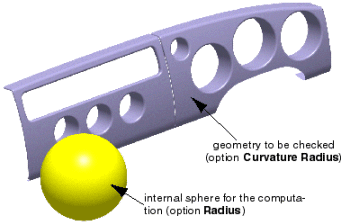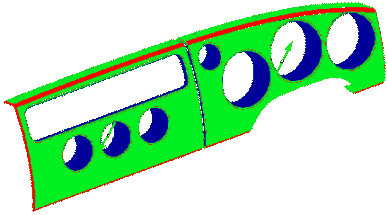About Head Impact Analyses | ||||
|
| |||
- Activate one of the display modes Shading with Material or Shading with Material and Edges. During execution of the head impact analysis, you can display the tesselation of the selected surface by activating the display mode Wireframe. Note that the display of the analysis result is not possible in this display mode!
- The head impact analysis cannot be used on surface clusters with non-manifold edges (common edges of adjacent surfaces deviating from each other, thus causing gaps or overlaps). If necessary, the surfaces must be joined using the command Join with an appropriate tolerance.
- The head impact analysis can only be carried out temporarily and cannot be saved.
Increased demands on the passive safety for automobiles are affecting to an increasing degree the protective properties in potential regions of head impact at the exterior and interior of a vehicle. The Head Impact Analysis has been developed especially for the requirements of the automobile industry. It can be used to detect sharp edges and corners at a 3D model that may cause injuries.
A sphere simulating a human head with a radius to be defined is used as test object. The region of the selected surface cluster where the sphere is rolled along, will be checked for curvature radii below a minimum value. Critical zones are marked in red. Afterwards, the detected areas should be remodelled until they meet the required safety standards. 
Interpretation of the Analysis Result
The analysis is displayed in the following colors:
| Color | Meaning |
|---|---|
| Red | The curvature radius is lying below the minimum, sharp edges/corners are found. |
| Green | The curvature radius is lying above the minimum, sharp edges/corners are not found here. |
| Blue | The sphere does not touch the geometry, no radius check is done here. |